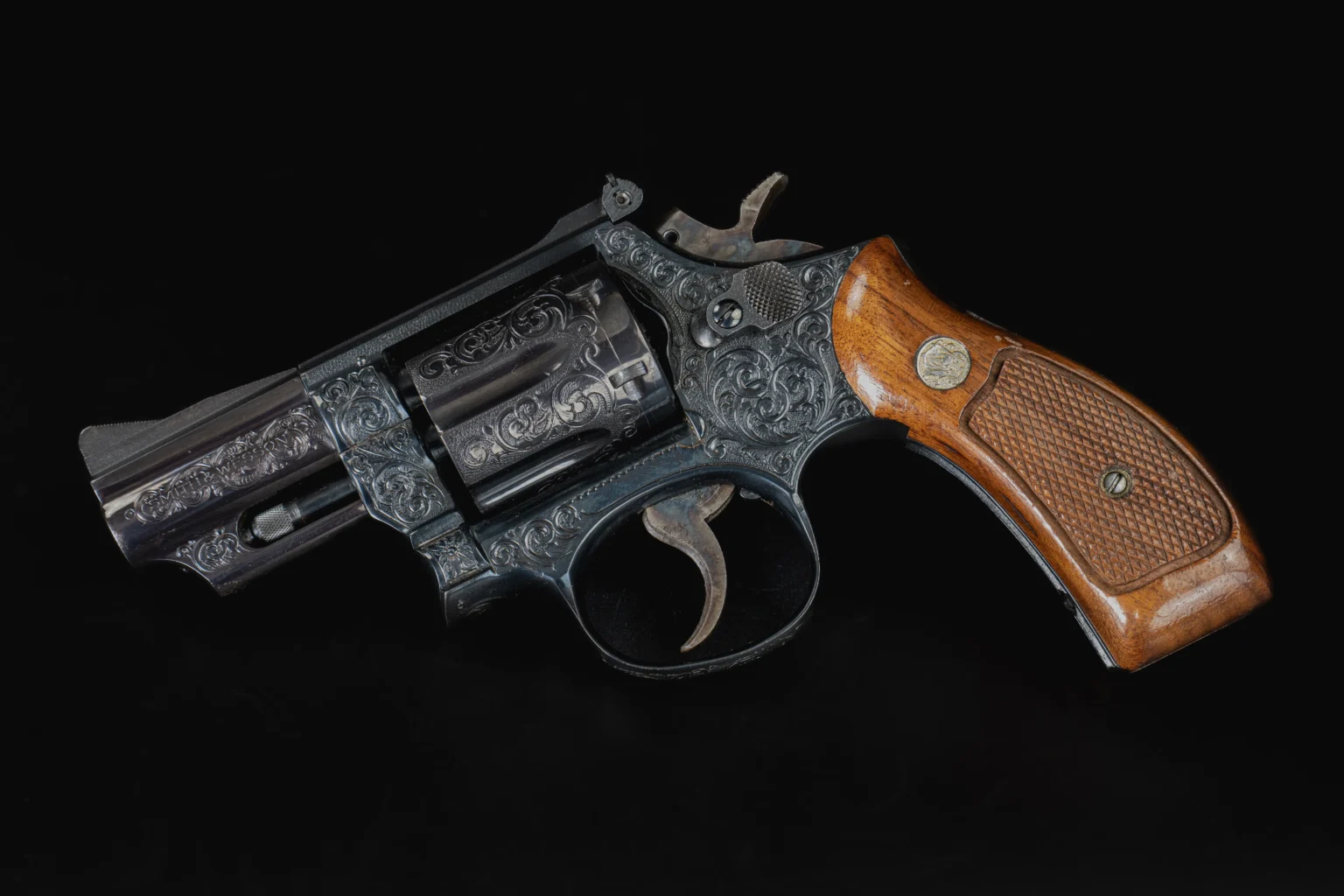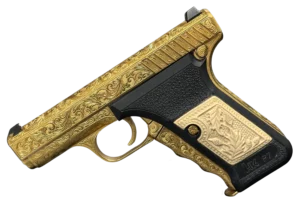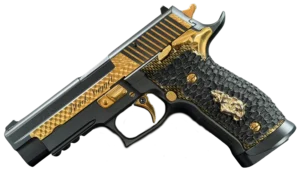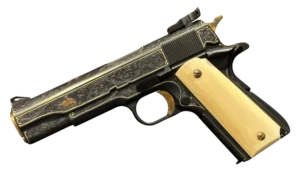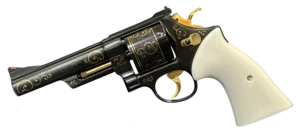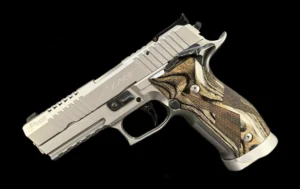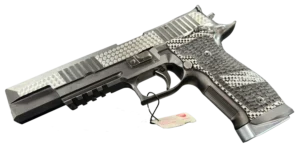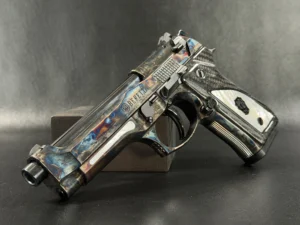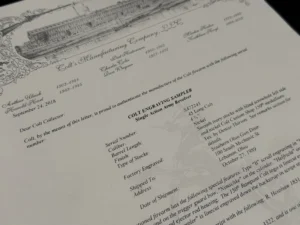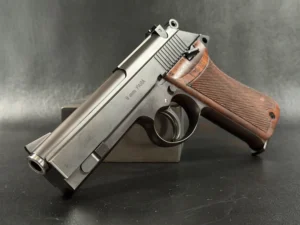Key Takeaways:
- Engraved guns are more than just weapons — they’re stories told in steel: Whether it’s a custom scroll from a master engraver or a factory piece with a bold design, each one reflects a moment, a mindset, or a maker’s hand. If you’re collecting, you’re not just buying objects — you’re curating little echoes of history.
- Learn the craft before you chase the gold: Understanding the difference between hand-cut, etched, and laser work isn’t just a technicality — it’s the difference between recognizing true artistry and falling for mass-market flash. The more you know, the sharper your eye (and the smarter your purchases).
- This isn’t just about money. It’s about meaning: Sure, some engraved guns go up in value. But the real return comes from the hunt, the learning, the people you meet along the way — and maybe the chance to pass something incredible down to the next person who’ll appreciate it just as much.
Let’s be honest — in the world of firearms, there’s something about an engraved gun that just stops you in your tracks.
You’re not just looking at a weapon anymore. You’re looking at a story — in metal, in wood, in the steady hand of someone who probably spent weeks (if not months) etching life into steel.
Engraved guns live at the intersection of form and function, and if you’re even remotely curious about collecting them, you’ve already felt the pull. But here’s the thing: it’s not just about “ooh, shiny.” There’s a lot to learn. History, technique, artistry, market nuance, even the ethics of where some of these pieces come from.
This guide? It’s for the curious — whether you’re brand new to the world of engraved firearms or a few years into your obsession. We’ll talk about the beauty, the baggage, the brass-tacks stuff like pricing and provenance, and yeah, we’ll also nerd out over the artistry a little.
So let’s get into it.
Engraving Isn’t Just Decoration — It’s a Language
Before guns, it was armor. Blades. Shields. Human beings have been engraving their tools since they figured out how to make metal hold an edge. Why? Maybe to show off. Maybe to tell a story. Maybe just because they could.
Gun engraving grew from that same impulse. At first, it was mostly symbolic — coats of arms, noble crests, markings of allegiance or rank. But over time, it got more poetic. More expressive. A well-engraved firearm could show off nature scenes, religious imagery, political allegiances, or just some serious swagger.
In Europe, especially in places like Germany and Italy, engraving became this insanely precise, deeply traditional art. Picture lush scrolls, woodland animals mid-leap, hunters frozen in gold relief. The kind of stuff you’d find on a high-end double rifle handed down for generations.
Now cut to America in the 1800s — the guns are rougher, the engraving bolder. Think: scrolls, sure, but also eagles, flags, geometric patterns, all radiating that restless frontier energy. Even Buffalo Bill got in on it — he famously owned a Winchester with a gold buffalo head on it. Not subtle, but kind of amazing.
Some of these pieces were owned by people who shaped history. Others? Just regular folks who wanted something beautiful. Either way, every engraved gun carries a fingerprint — the engraver’s, the owner’s, the culture’s.
So What Actually Is Engraving, Technically Speaking?
Alright, let’s nerd out for a sec. Not all engraving is created equal, and if you’re collecting, it pays to know what you’re actually looking at.
Hand Engraving
The gold standard. Done with tiny steel tools called gravers. Every cut is made by hand, often under a magnifier, sometimes under a microscope. This stuff takes time, patience, and borderline obsession. The result? Deep cuts, flowing curves, and tiny details that feel alive. No two pieces are ever the same.
Acid Etching
More industrial, a bit of a shortcut — but not necessarily bad. The artist coats the surface in a resist, scratches out the design, then bathes the metal in acid. The acid eats away the exposed lines, leaving behind a pattern. Less labor-intensive, but also less soul. The designs can be sharp, but they don’t have the depth or human touch of a hand-cut piece.
Laser Engraving
The new kid on the block. Fast, clean, hyper-precise. A laser literally burns the pattern into the metal. It’s popular for mass production, and some of the results look cool — especially when paired with modern aesthetics — but if you’re hunting for character and texture, this probably isn’t your jam.
And then there are the styles — American scroll, German oak leaf, English rose and scroll, even Japanese-style motifs. Once you know what to look for, you’ll start spotting these styles in the wild. And trust me, that moment of recognition? Super satisfying.
Factory vs. Custom: The Two Worlds of Engraved Guns
This is where collecting gets interesting.
Factory-Engraved Guns
You’ll find these from big manufacturers — Colt, Browning, Beretta, you name it. Some are limited runs, some mass-produced. They might be laser-engraved or acid-etched, and the detail ranges from “kind of cool” to “whoa.” Factory pieces tend to be more affordable and are a great way to dip your toe in.
But here’s the catch: they’re not one-of-a-kind. And in collecting, uniqueness matters.
Custom-Engraved Guns
This is where the magic happens. One engraver. One gun. One vision.
These pieces aren’t just weapons — they’re collaborations between metal and imagination. Often built to order or as part of a very limited run, they carry the artist’s fingerprint in every line. You’ll see the name of the engraver signed somewhere discreet — and collectors learn those names like art lovers know their painters.
Want something that looks like it belongs in a museum? This is where you go.
What Makes a Gun “Collectible” Anyway?
Here’s where the romance meets reality. Beauty is one thing — but if you’re serious about collecting, you’ve gotta think like an appraiser too.
Condition
This one’s pretty self-explanatory. Clean lines, intact bluing, crisp woodwork — those are wins. But not all wear is bad. Some patina adds charm, especially if the piece is 100+ years old. You just want to make sure the engraving hasn’t been buffed into oblivion.
Rarity
If a gun was made in tiny numbers, or the engraving was done by a now-famous artist, you’re looking at something with real value. But beware the hype — just because something’s rare doesn’t mean people actually want it. Desire matters.
Provenance
Who owned it? Where’s it been? Any cool backstory? A firearm that belonged to a war hero or celebrity — and comes with rock-solid documentation — is going to be worth a lot more. That little piece of paper? It can add thousands to the price.
Also… let’s be real: the world is full of fakes. Re-engraved pieces. Franken-guns cobbled together from parts. If something feels off, walk away or bring in an expert. Better to miss a deal than get burned.
The Legal and Ethical Side of Collecting
Yeah, we’ve gotta talk about this.
Gun laws vary wildly depending on where you live. Some places treat antique firearms the same as toaster ovens. Others? You need a stack of permits just to own a flintlock. And if you’re importing or exporting pieces internationally, buckle up — there’s a web of red tape just waiting to tangle you.
Do your homework. And don’t just take a seller’s word for it — check the laws yourself. Especially when crossing state or country lines.
Also: Ethics.
Some engraved guns have baggage. Military pieces from brutal conflicts. Indigenous weapons taken under shady circumstances. It’s up to you to ask the tough questions. Where did this come from? Should it be in a private collection?
You’re not just a buyer. You’re a steward of history. Handle that responsibility with care.
Finding and Buying: The Hunt is Half the Fun
So where do you find these pieces?
Gun Shows
Still one of the best ways to see engraved guns up close. You get to handle the piece, talk to the seller, and maybe even haggle. Bonus: you’ll meet some real characters.
Auctions
Rock Island Auction. Morphy. Holt’s. These places move serious metal. Prices range from “huh, that’s reasonable” to “oh my god someone just paid six figures for a pistol.” Even if you’re not buying, following these auctions is a crash course in what’s hot, what’s rare, and what people are paying.
Online
Yep, the internet’s full of options. But it’s also full of scams and blurry photos. Stick to reputable sites. Ask for detailed images. If you can’t get a straight answer about provenance or condition — move on.
Taking Care of What You’ve Got
An engraved gun is part firearm, part artwork — and you need to treat it accordingly.
Store it in a stable environment. No moisture, no extreme temps. Clean it gently. Use a soft cloth, skip the harsh chemicals. And for older pieces, especially antiques? Consider professional servicing now and then. You don’t want to be the person who accidentally ruins a century-old hand engraving with a metal brush.
And here’s a tip: photograph your collection. Not just for insurance, but because it’s a joy to scroll through and revisit. These are stories, remember? Document them.
Join the Club (Even if It’s Just Online)
You don’t have to go it alone. In fact, you shouldn’t.
There are online forums, social media groups, and full-blown associations devoted to engraved guns and custom firearms. They’ll teach you stuff no book ever will — like how to spot a fake, how to ID obscure engraver marks, or when to jump on a deal.
Also, people love to talk about their collections. It’s infectious. Don’t be shy.
Workshops, engraving demos, collector meetups — they’re all worth checking out. You might not be looking to pick up a graver yourself, but understanding the process will totally change how you see the finished product.
Guns as Investment — Or Maybe Something Deeper
So… can you make money collecting engraved guns?
Sure. Sometimes. If you know what you’re doing, have a good eye, and a bit of luck, your collection could absolutely go up in value.
But don’t go into it like it’s real estate. The market can be fickle. Tastes change. Engravers fall in and out of favor. And if you’re buying just to flip, you’ll probably miss the point.
Instead, think about this: what are you leaving behind?
An engraved firearm — especially one passed down — becomes a story that keeps unfolding. A connection to family, to place, to something bigger. One day, someone might hold your collection and wonder about you the same way you’re wondering about the person who owned it before.
That’s the kind of investment that doesn’t show up on a spreadsheet.
Final Thoughts (But Not Really the End)
Look — collecting engraved guns isn’t just a hobby. It’s a way of seeing.
You start to notice the tiny details. You learn to read metal like a language. You gain this strange respect for the artists who spent their lives putting beauty into cold steel.
And yeah, you start to tell stories. To anyone who’ll listen. (Or maybe just to yourself.)
So if you’re thinking about jumping in — do it. But do it with eyes open, heart engaged, and a deep appreciation for the craft. You’re not just collecting objects. You’re collecting time. Stories. Legacy.
And that? That’s something worth holding onto.
Frequently Asked Questions
Both, honestly. Some folks buy them purely as showpieces — especially high-end, hand-engraved models — while others occasionally take them to the range. Please keep in mind that firing an old or rare gun can affect its condition and value. If it’s a museum-worthy piece, perhaps let it remain as it is.
Great question — and a tricky one. Hand engraving typically features depth and subtle variations that lend it character, much like brushstrokes in a painting. Machine work, especially laser work, tends to be too perfect — uniform depth, sharp edges, and somewhat cold: a magnifying glass and some practice help. Or ask someone who’s been around the block.
Depending on the piece. Limited editions from major manufacturers can retain solid value, especially if they’re in excellent condition and accompanied by documentation. They’re also a more affordable way to get started before jumping into custom or antique territory.
Start with the basics: condition, provenance, and authenticity. Ask who did the engraving, when it was done, and whether the gun has been modified. Don’t be afraid to walk away if something feels off. Trust your gut — and maybe a trusted appraiser too.
Sometimes. If you know what you’re doing, you can build a collection that appreciates over time. However, values can fluctuate based on trends, rarity, and who is buying. If you’re in it just for the profit, it might not be the smoothest ride. But if you’re in it for the craft, the history, and the love of the art — that’s where the real return is.


